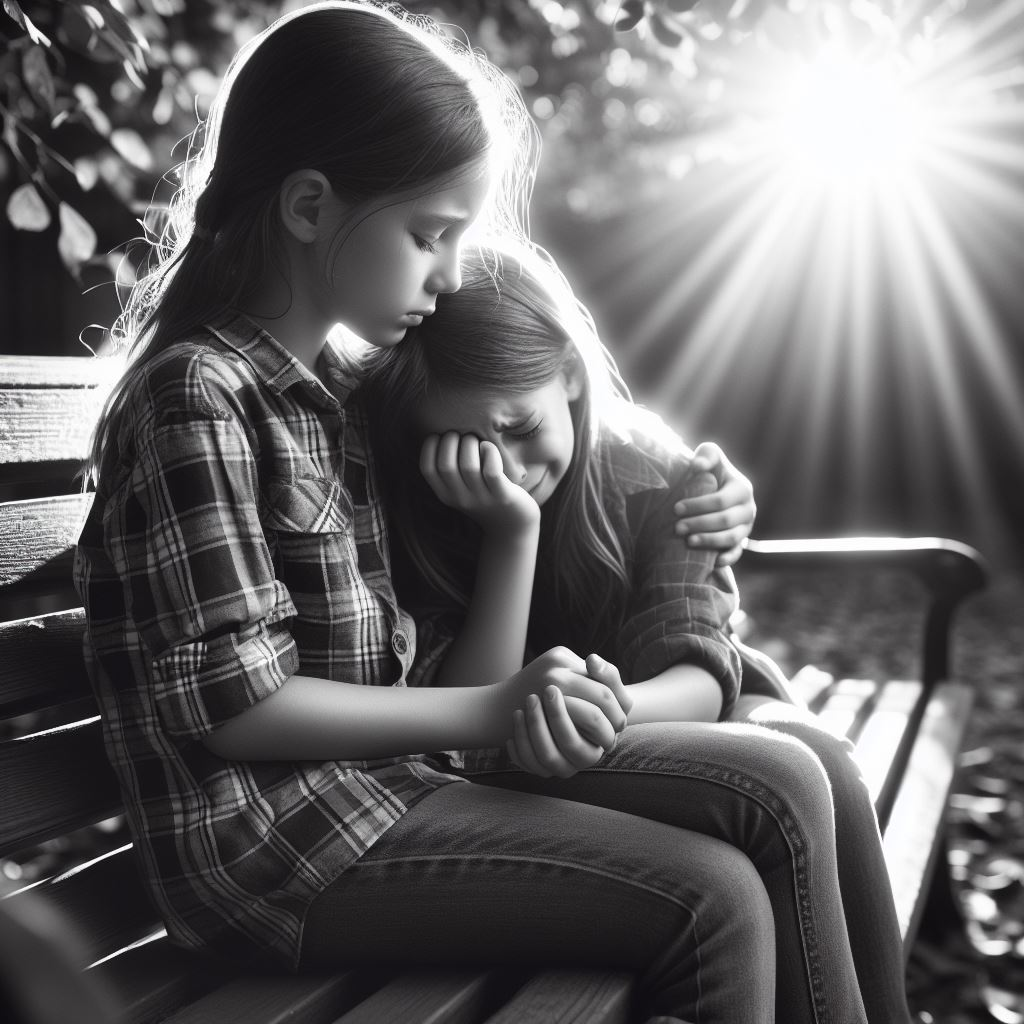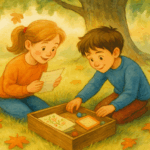In my ten years wrangling kindergartners and cheering on fifth graders, I’ve seen the power of empathy firsthand. It’s like a secret superpower that lets kids see the world through someone else’s eyes. But explaining it? That can feel tricky. Don’t worry, parents and teachers! We’ve got this. Get ready for some awesome tips, fun activities, and real-life examples to turn your little ones into empathy ninjas!
This post is gonna take you on a deep dive into the world of empathy for kids. We’ll break down what empathy is all about, how it’s different from just feeling sorry for someone (sympathy), and why it’s super important for your child’s Social-Emotional Learning (SEL) and overall development. We’ll also show you some awesome benefits of strong empathy and give you all kinds of practical tips on how to teach and nurture this amazing skill in your little ones.
- Related: 18 Empathy quotes for kids
Unveiling the power of empathy
Alright, parents and teachers, let’s delve into Emotional Intelligence (EI). This crucial skill helps children understand their own emotions and those of others. Empathy is a key player here, like the quarterback calling the shots. Strong EI benefits kids in amazing ways! They develop better communication skills, expressing themselves clearly instead of resorting to meltdowns. It also fosters stronger relationships as they learn to see things from another child’s perspective. Pretty powerful stuff, right?
Empathy vs. Sympathy: Understanding the key difference for your child
Let’s clear up a common confusion: empathy versus sympathy. Empathy is like seeing the world through someone else’s glasses. It has three parts: understanding what they’re thinking (cognitive), feeling what they’re feeling (emotional), and wanting to help (compassionate).
Sympathy, on the other hand, is more like feeling bad for someone. Imagine your friend trips and scrapes their knee. With empathy, you’d understand their pain (ouch!), feel sad for them (aw!), and maybe grab a bandaid (let’s fix that up!). Sympathy might just be the “aw!” part. See the difference?
The empathy journey: When and how it develops
We’re about to witness a magical moment in your toddler’s development: the empathy leap! This usually happens around 18 months, when their little brains start to grasp the concept of “hey, other people have feelings too!” It might look like noticing a classmate crying and offering a hug, or sharing a favorite toy with a new friend. Keep an eye out for these sweet signs that your tiny human is developing empathy – it’s a heartwarming process to witness!
Fostering empathy throughout childhood
The empathy train doesn’t stop at toddlerhood, folks! Throughout childhood and adolescence, empathy continues to grow and become more nuanced. Think of it like building a muscle – the more you use it, the stronger it gets. This is where we, as parents and teachers, come in! By providing ongoing guidance and support, we can help kids navigate complex emotions, understand different perspectives, and truly connect with others. It’s a team effort, but the rewards are incredible.
Equipping your child: Powerful tools to teach empathy
Games & Activities
Alright parents, let’s get down to the fun part: equipping your child with empathy-boosting superpowers! We’ve got a toolbox full of engaging games and activities that will make learning about empathy a blast.
Here are a few favorites, perfect for different age groups:
Story Time Superstars: For younger children, reading stories with diverse characters and emotions is a win-win. Pause after key moments and ask, “How do you think the character feels?” or “What would you do if you were in their shoes?” It sparks those empathy gears in their minds!
Role-Playing Champions: For all ages, role-playing is a fantastic tool. Act out different scenarios – maybe a friend feels left out, or someone loses a favorite toy. By stepping into another’s shoes, kids practice understanding different perspectives.
Charades with a Twist: Feeling Charades gets an empathy upgrade! Instead of acting out emotions, have kids act out how someone might react to a situation. It encourages them to think about the “why” behind the emotions.
These are just a few ideas to get you started. Remember, the key is to make it fun and engaging!
Empathy in action: Script and examples to explain empathy to your child
Okay parents, ever feel stuck explaining empathy to your little one? No worries! Here’s a simple script to get you started:
You: Hey there, sweetie. I noticed you seemed sad when your friend Sarah wasn’t chosen for the game.
Child: (Nods)
You: Can you imagine how Sarah might be feeling right now? Maybe a little left out or bummed?
Child: (Thinks for a moment) Yeah…
You: That’s empathy! It’s about understanding how others feel. Maybe next time, we can ask the teacher if there’s a way for everyone to join in!
This is just a starting point, of course. Use everyday situations as practice! Did someone trip and scrape their knee? Talk about how they might feel and what you can do to help. Empathy in action – it’s a beautiful thing!
Lead by example: Show your child the power of empathy
Don’t forget, parents – you’re your child’s biggest role model! Show them the power of empathy in action. This means being there to listen when they’re down, validating their feelings, and offering support. Even small gestures, like apologizing when you bump someone or helping a neighbor carry groceries, go a long way in teaching empathy through everyday moments.
Unpack their emotions and understanding
Kids gotta know their own feelings before they can grasp someone else’s, right? That’s why helping them identify their emotions is key. Labeling feelings like “happy,” “frustrated,” or “sad” is a great first step. This builds the foundation for recognizing those emotions in others – like puzzle pieces clicking into place!
Unlocking potential: Benefits of strong empathy
Alright parents, let’s talk about the future! Empathy isn’t just a feel-good thing; it’s a life skill. When kids can understand and connect with others’ feelings, they build strong friendships. They become better teammates, knowing how to celebrate victories and support each other through tough times.
This skillset translates beautifully into adulthood too. Imagine your child excelling in their future career because they can collaborate effectively, manage conflict with compassion, and build trust with colleagues. Empathy truly paves the way for success in all areas of life!
Building strong communities: How empathy makes us better together
Empathy isn’t just about one-on-one friendships, folks. It’s the glue that holds strong communities together! When kids can see the world through another’s eyes, they become more compassionate and understanding.
Imagine a schoolyard where kids can resolve conflicts peacefully because they can understand each other’s perspectives. Or a classroom where students celebrate each other’s differences with kindness. That’s the power of empathy in action – building bridges of understanding and creating a world where everyone feels like they belong.
Troubleshooting challenges: Addressing empathy concerns
Let’s address the elephant in the room for a second: empathy development isn’t always sunshine and rainbows. Some children might seem less outwardly empathetic than others. Here’s the thing – empathy is a complex skill that unfolds at its own pace. If you have concerns, don’t hesitate to reach out to your child’s teacher or pediatrician.
There are also fantastic resources online and in libraries that can offer support and guidance. Remember, early intervention can make a big difference. But most importantly, stay positive! With patience, encouragement, and the tips in this post, you can nurture the amazing empathy superpower within your child.
The empathy advantage
So, there you have it, parents and teachers! We’ve dived deep into the world of empathy for kids. Remember, empathy is the magic ingredient for strong social connections, a compassionate world, and even future career success. It’s a skill worth nurturing! By using the tips and activities in this post, you can help your child develop this superpower.
Remember, it’s a journey, not a destination. Celebrate the small victories, offer support along the way, and watch your little one blossom into an empathetic and kind individual. You’ve got this!
Further Reading
Here’s an interesting study presented as a dissertation of the requirements for the Doctor of Philosophy in Early Childhood Education – Determining if Classroom Pets as part of an Empathy-Based Intervention Affect Public Elementary School Students’ Empathy













